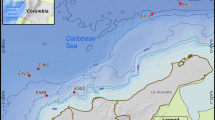Abstract
Tests to detect the presence of piezophilic Shewanella strains in the deep-sea sediments of the west, mid- and east Pacific at different depths were done by amplification of previously identified pressure-regulated operons (ORF1,2 and ORF3). The operon fragments were detected in all the deep-sea sediment samples, indicating the broad presence of piezophilic deep-sea Shewanella species or related species in the deep-sea sediments across the Pacific. Extremophiles were isolated from the deep-sea sediment of the west Pacific under atmospheric pressure. Two psychrophilic/psychrotrophic strains, WP2 and WP3, were assigned to the Shewanella genus as determined by their 16S rDNA sequences. WP2 and WP3 were both capable of amplifying pressure-regulated operons; the sequences of the pressure-regulated operons of WP2 and WP3 share high identity between each other, but have more differences from those of S. benthica and S. violacea. The major fatty acids of WP2 and WP3 are 3OH-i-13:0, 14:0, i-15:0, 16:0, 16:1, 18:1, and 20:5. Combined phenotypic analysis, 16S rDNA sequences, and DNA–DNA hybridization results suggest that WP2 and WP3 are two new deep-sea Shewanella species.



Similar content being viewed by others
References
Bowman JP (2001) Methods for psychrophilic bacteria. In: Paul JH (ed) Marine microbiology. (Methods in microbiology vol 30) Academic, London, pp 591–611
DeLong EF, Franks DG, Yayanos AA (1997) Evolutionary relationships of cultivated psychrophilic and barophilic deep-sea bacteria. Appl Environ Microbiol 63:2106–2108
Deming JW, Hada H, Colwell RR, Luehrsen KR, Fox GE (1984) The nucleotide sequence of 5S rRNA from two strains of deep-sea barophilic bacteria. J Gen Microbiol 130:1911–1920
Ivanova EP, Sawabe T, Hayashi K, Gorshkova NM, Zhukova NV, Nedashkovskaya OI, Mikhailov VV, Nicolau DV, Christen R (2003) Shewanella fidelis sp. nov., isolated from sediments and seawater. Int J Syst Evol Microbiol 53:577–582
Kato C, Nogi Y (2001) Correlation between phylogenetic structure and function: examples from deep-sea Shewanella. FEMS Microbiol Ecol 35:223–230
Kato C, Smorawinska M, Sato T, Horikoshi K (1996) Analysis of a pressure-regulated operon from the barophilic bacterium strain DB6705. Biosci Biotechnol Biochem 60:166–168
Kato C, Ikegami A, Smorawinska M, Usami R, Horikoshi K (1997a) Structure of genes in a pressure-regulated operon and adjacent regions from a barotolerant bacterium strain DSS12. J Mar Biotechnol 5:210–218
Kato C, Li L, Tamaoka J, Horikoshi K (1997b) Molecular analyses of the sediment of the 11000-m deep Mariana Trench. Extremophiles 1:117–123
Kato C, Li L, Nogi Y, Nakamura Y, Tamaoka J, Horikoshi K (1998) Extremely barophilic bacteria isolated from the Mariana Trench, Challenger Deep, at a depth of 11,000 meters. Appl Environ Microbiol 64:1510–1513
Li L, Kato C, Nogi Y, Horikoshi K (1998) Distribution of the pressure-regulated operons in deep-sea bacteria. FEMS Microbiol Lett 159:159–166
Nogi Y, Kato C, Horikoshi K (1998) Taxonomic studies of deep-sea barophilic Shewanella strains and description of Shewanella violacea sp.nov. Arch Microbiol 170:331–338
Nogi Y, Kato C, Horikoshi K (2002) Psychromonas kaikoae sp. nov., a novel piezophilic bacterium from the deepest cold-seep sediments in the Japan Trench. Int J Syst Evol Microbiol 52:1527–1532
Saitou N, Nei M (1987) The neighbor-joining method: a new method for reconstructing phylogenetic trees. Mol Biol Evol 4:406–425
Takami H, Kobata K, Nagahama T, Kobayashi H, Inoue A, Horikoshi K (1999) Biodiversity in deep-sea sites located near the south part of Japan. Extremophiles 3: 97–102
Acknowledgments
Thanks to the crews on DaYang No. 1 for assisting with sample collection. This work was partly supported by National “973” program G2000078500, COMRA foundation DY105-4-2-1. We also thank Dr. Chiaki Kato for helpful discussions during the course of the work.
Author information
Authors and Affiliations
Corresponding author
Additional information
Communicated by K. Horikoshi
Rights and permissions
About this article
Cite this article
Wang, F., Wang, P., Chen, M. et al. Isolation of extremophiles with the detection and retrieval of Shewanella strains in deep-sea sediments from the west Pacific. Extremophiles 8, 165–168 (2004). https://doi.org/10.1007/s00792-003-0365-0
Received:
Accepted:
Published:
Issue Date:
DOI: https://doi.org/10.1007/s00792-003-0365-0




